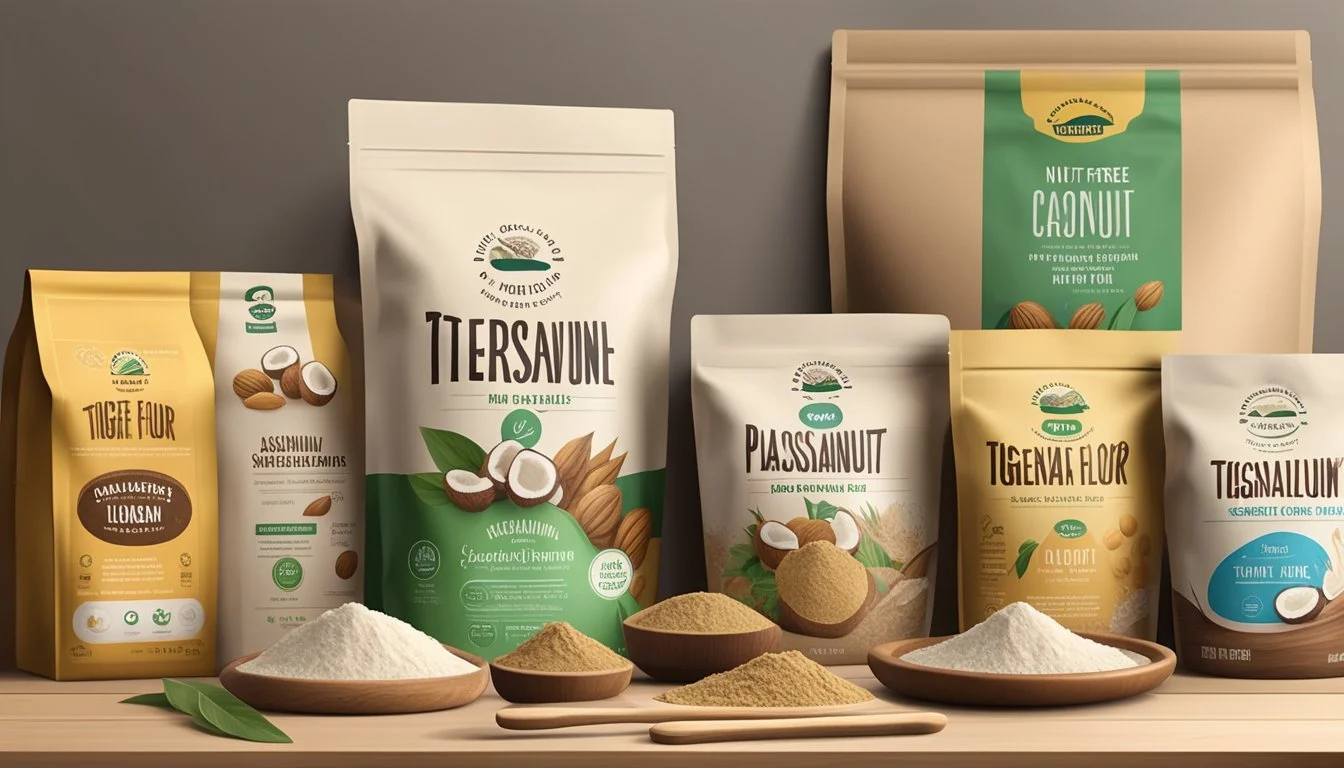Tigernut Substitutes
Top Alternatives for Allergy-Friendly Baking
Tigernut flour, derived from the dried and ground tuber of the Cyperus esculentus plant, is a popular staple in health-conscious and dietary-restrictive cooking. Praised for its naturally sweet flavor and nutrient-rich profile, it is often used as a grain- and nut-free alternative to traditional flours in baking, appealing to those with gluten sensitivities and nut allergies. Rich in fiber, minerals, and vitamins, tigernut flour provides a versatile base for a variety of recipes, ranging from baked goods to smoothies.
However, despite its benefits, some may seek substitutes for tigernut flour due to availability, cost, or specific recipe needs. Fortunately, there are several alternative flours that can cater to similar dietary requirements and provide comparable results in the kitchen. Coconut flour, for example, is another gluten-free option that's commonly recommended for its fine texture and mild taste, making it a suitable half-measure substitute for tigernut flour. Arrowroot powder, a starch extracted from tropical tubers, serves as an excellent thickening agent in sauces, soups, and baking recipes, though its lack of protein contrasts with the more nutrient-dense tigernut flour.
Choosing the right substitute for tigernut flour involves considering the specific texture, taste, and nutritional content desired in the final dish. Some alternatives like potato flour offer a boost in protein, while others may provide different consistencies or flavors. Whether adjusting for allergies, dietary preferences, or simply experimenting with new ingredients, these substitutes are valuable additions to any kitchen repertoire.
Understanding Tigernut Flour
Tigernut flour is gaining popularity as a nutritious, gluten-free alternative with a distinct earthy flavor. It plays a versatile role in various dietary considerations such as paleo and gluten-free diets due to its composition and health benefits.
Origins and Composition
Tigernut flour is derived from tiger nuts, small root vegetables from the Cyperus esculentus plant, not actually nuts. They are rich in fiber, resistant starch, and healthy fats. The flour made from these tubers retains these properties, offering a fine, slightly sweet and nutty taste.
Nutrient Presence in Tigernut Flour Fiber High Protein Moderate Resistant Starch High Healthy Fats Moderate Vitamins & Minerals Present
Health Benefits
Tigernut flour hosts a myriad of health benefits. It is naturally rich in prebiotic fiber which aids in maintaining gut health. The flour's resistant starch content is beneficial for the gut microbiome, acting as a fuel source for beneficial bacteria. Furthermore, tiger nut flour is a source of vitamins and minerals such as vitamin E and iron. Since it's gluten-free, it's also an excellent option for those with celiac disease or gluten intolerance.
Culinary Uses
As for its culinary uses, tiger nut flour is a versatile ingredient in the kitchen. Its earthy flavor complements baked goods and it has a sweet profile that can reduce the need for added sugars. Its fibrous content provides structure to gluten-free recipes, though it does not behave exactly like wheat flour. It's often used in paleo recipes, including cookies, muffins, and bread, replicating the texture and taste of traditional flour with a nutritional boost.
Reasons for Substituting Tigernut Flour
In exploring alternatives to tigernut flour, individuals often consider dietary restrictions, local availability of the flour, and their own taste preferences. These factors contribute to the need for suitable substitutes.
Dietary Restrictions
For individuals with allergies or nut sensitivities, even though tigernuts are not true nuts, the name might cause confusion or concern. As it is always better to err on the side of caution, they might seek alternatives that are explicitly labeled nut-free. Moreover, those with gluten sensitivities or celiac disease might opt for a substitute to vary their sources of gluten-free flour, despite tigernut flour being naturally gluten-free. Substitutes also come into play when individuals require flours with different dietary fiber compositions or when catering to a grain-free diet, as tigernut flour itself is a viable option for those avoiding grains.
Availability Concerns
Tigernut flour may not be readily available in all regions, prompting a search for more accessible alternatives. Local supermarkets or health food stores may not stock tigernut flour, necessitating a different flour for baked goods or other recipes.
Taste Preference
The distinctive taste of tigernut flour can be a deciding factor for some. While tigernut flour has a sweet, nutty flavor, individuals may prefer the taste of other flours in their baking and cooking. Finding a substitute that aligns more closely with their taste preferences or the flavor profile of the dish they’re creating is important for their culinary satisfaction.
Best Overall Substitutes for Tigernut Flour
When looking for substitutes for tigernut flour, one should consider factors such as taste, texture, and how the flour behaves in baking. The best overall substitutes are flours that offer a similar nutty flavor and are also gluten-free and grain-free, making them suitable for those with dietary restrictions.
Almond Flour
Almond flour is a versatile grain-free flour that closely mimics the nutty flavor of tigernut flour. In baking, it yields a moist and tender texture which makes it an excellent option for cakes and cookies. Since it is also gluten-free, it serves as a healthy substitute, especially for those following a paleo diet.
Flavor: Nutty, similar to tigernut flour
Baking Behavior: Provides moisture to baked goods
Texture Contribution: Tender and moist
Coconut Flour
Coconut flour is another grain-free, gluten-free flour known for its health benefits. It is highly absorbent and can impart a soft, fine texture to baked goods. However, one should use about half the amount of coconut flour when substituting for tigernut flour due to its high absorbency. Its mildly sweet taste complements recipes that benefit from a slightly sweet, nutty flavor.
Flavor: Mildly sweet and nutty
Baking Behavior: Highly absorbent; use less quantity
Texture Contribution: Soft and fine
Cassava Flour
Cassava flour is a grain-free, gluten-free flour that is often used as a 1:1 substitute for tigernut flour in various recipes. It is neutral in flavor, which makes it a versatile option for both sweet and savory dishes. The flour’s texture is similar to that of wheat flour, which allows it to contribute to a smooth and chewy texture in baked items.
Flavor: Neutral, adaptable to many recipes
Baking Behavior: Substitute in equal measure to tigernut flour
Texture Contribution: Smooth and sometimes chewy
Nut-Free Tigernut Flour Alternatives
When looking for nut-free tigernut flour alternatives, individuals with nut allergies often turn to seed flours. These alternatives provide unique nutritional benefits, including protein content and minerals, and are suitable for gluten-free baking. They can be found in many health food stores or specialty sections of grocery stores.
Sunflower Seed Flour
Sunflower seed flour is made from finely ground sunflower seeds and serves as an excellent alternative to nut-based flours. It is particularly high in vitamin E and selenium, minerals that are beneficial for overall health. Its protein content is comparable to that of almond flour, making it suitable for those seeking a nut-free, protein-rich baking option. When using sunflower seed flour, one should note that it can sometimes impart a greenish hue to baked goods due to its chlorogenic acid content reacting with baking soda.
Profile: Nut-free, gluten-free, rich in vitamin E and selenium
Protein: Similar to almond flour
Usage: Can replace nut flours in a 1:1 ratio
Baking Note: May cause a green tint in finished products
Pumpkin Seed Flour
Pumpkin seed flour, derived from ground pumpkin seeds, is another nut-free substitute that is dense in nutrients. It boasts a high protein content and is laden with minerals like magnesium, zinc, and iron, supporting various bodily functions. This flour's rich and earthy flavor makes it an ideal ingredient for both sweet and savory gluten-free recipes. Bakers may need to adjust the moisture content of recipes slightly, as the flour can have different absorption qualities compared to tigernut flour.
Profile: Nut-free, packs a punch of minerals like magnesium, zinc, and iron
Protein: High
Flavor: Rich and earthy, versatile for both sweet and savory dishes
Baking Tip: Monitor and adjust moisture levels in recipes
Grain-Free Options Comparable to Tigernut Flour
When considering grain-free alternatives to tigernut flour for baking, it is important to focus on options that maintain a recipe's integrity while providing similar nutritional benefits. The following flours are not only grain-free, they also complement the paleo and gluten-free diets, offering a spectrum of flavors and textures to cater to a variety of culinary needs.
Arrowroot Flour
Arrowroot flour is a light, gluten-free, and grain-free starch that is an excellent thickener and binding agent in baking. It is derived from the rhizomes of the arrowroot plant and is an acceptable substitute for tigernut flour when a neutral flavor and lighter texture are desired. It's high in carbohydrates but low in calories, and it can be especially useful in recipes requiring a smooth consistency.
Carbohydrates: High
Gluten-Free: Yes
Paleo-Friendly: Yes
Use: Thickening agent, binding agent
Tapioca Flour
Tapioca flour, sourced from cassava root, is another starchy, gluten-free alternative. This paleo-friendly flour has a slight sweetness and provides a chewy texture that mimics tigernut flour well in baked goods. It's a versatile choice that works well in a 1:1 ratio for recipes that require a slight elasticity.
Carbohydrates: Moderate
Fiber Content: Low
Gluten-Free: Yes
Grain-Free: Yes
Buckwheat Flour
Despite what its name suggests, buckwheat flour is completely grain-free and gluten-free, making it an ideal substitute for tigernut flour. It is high in fiber and has a rich, nutty flavor, which adds depth to recipes. Buckwheat flour is suitable for more robust baked goods and is well-regarded for its nutritional profile, including protein content.
Fiber Content: High
Gluten-Free: Yes
Paleo-Friendly: Typically, though often debated due to its name
Taste: Nutty, hearty
Each substitute offers unique qualities, from arrowroot's smooth consistency to tapioca's elasticity and buckwheat's rich flavor profile. Bakers can choose based on the specific needs of their recipe and dietary preferences.
Baking with Tigernut Flour Substitutes
When baking with tigernut flour substitutes, individuals should note alterations in texture and flavor. These substitutes can cater both to gluten-free diets and unique taste preferences.
Adjusting for Texture and Consistency
Selecting the right substitute for tigernut flour in baking is critical for achieving the desired texture and consistency of baked goods. Almond flour can replace tigernut flour on a 1:1 basis, and it can be particularly effective in items like cakes and cookies. Tapioca flour, another gluten-free alternative, offers a light and powdery texture ideal for breads and pizza crust. For a clear thickening effect, arrowroot powder works well and can help in creating the right consistency for items like sauces and fillings for pies. It's essential to remember that substitutes may absorb liquids differently, so bakers may need to adjust the quantity of wet ingredients accordingly.
Substitute Best Used for Notes Almond Flour Cakes, Cookies Nut-based, protein-rich, moist texture Tapioca Flour Breads, Pizza Crust Starchy, light, airy texture Arrowroot Sauces, Pie Fillings Thickening agent, creates a jelly-like texture
Sweet and Savory Applications
Tigernut flour substitutes can be adeptly used across a spectrum of sweet and savory baked goods. They can provide a diverse range of flavors and textures suitable for different types of pastry products. Almond flour, with its inherent nutty flavor, enhances both sweet and savory profiles, making it suitable for muffins and pancakes. For sweet applications where additional moisture is desired, such as in certain cake recipes, almond flour can also add a subtle sweetness, potentially reducing the need for sugar. Savory dishes that require a crispy crust, such as pizza, can benefit from the light crispness of tapioca flour. It is crucial to look for recipes or guidelines online specific to each substitute, as they will address the unique baking properties and the ratios needed for successful results.
Comparative Nutrition Profiles
Choosing a substitute for tigernut flour involves considering various nutritional components, such as carbohydrate and fiber content, protein and fat comparisons, and the spectrum of vitamins and minerals.
Carbohydrate and Fiber Content
Tigernut flour, sourced from the root vegetable Cyperus esculentus, is not only rich in carbohydrates but also an excellent source of fiber. In comparison:
Almond flour: Similar carbohydrate content but with lower fiber.
Tapioca flour: Higher in carbs, lower in fiber, due to its extraction from cassava root starch.
Almond and tapioca flours are commonly used as substitutes, but one should note the fiber disparity, which is significant for digestive health and maintaining blood sugar levels.
Protein and Fat Comparisons
When evaluating flour substitutes, one should weigh the protein and fat content. Tigernut flour is moderate in protein and healthy fats. Here's how substitutes fare:
Potato flour: Higher in protein, providing a substantial protein boost.
Almond flour: Rich in healthy fats and higher in protein.
Substitutes like potato and almond flour can offer increased protein, which is vital for muscle repair and enzymatic activities.
Vitamins and Minerals
Flours made from nuts or tubers are often abundant in vitamins and minerals. Tigernut flour is no exception, providing a good source of potassium, magnesium, and iron. Substitute flours supply:
Almond flour: High in magnesium and calcium, but with a lower iron content.
Tapioca flour: Not as nutrient-dense, lacking several vitamins and minerals.
Each flour substitute carries its own set of micronutrients that contribute to overall health, including metabolic function and bone health.
Shopping for Tigernut Flour Substitutes
When shopping for tigernut flour substitutes, consumers should investigate both local and online availability, as well as the cost differences between various alternatives to make an informed purchase.
Local and Online Sources
Consumers can find tigernut flour substitutes at health food stores and specialty grocery stores. These local options often carry a selection of gluten-free flours that can be used as alternatives to tigernut flour like almond flour, tapioca flour, and arrowroot powder. For a wider variety and competitive pricing, online sources such as Amazon or health food retailers provide a convenient platform to browse and purchase a range of substitutes. Almond flour and tapioca flour are often readily available options.
Cost Comparisons
The cost of tigernut flour substitutes can vary considerably depending on the product and where it's purchased. Below is a comparison table that may help shoppers:
Substitute Approximate Cost (per cup) Notes Almond Flour $1.50 - $2.50 Widely available both online and in-store Tapioca Flour $0.50 - $1.00 Cost-effective, starchy substitute Arrowroot Powder $2.00 - $3.00 Pricier; used as a thickener and in baking Potato Flour $1.00 - $2.00 High in protein, suitable for gluten-free baking
The prices mentioned are estimates and can fluctuate based on product quality, brand, and the retailer. Generally, tapioca flour is among the more economic options, whereas almond flour and arrowroot powder might be on the higher end of the cost spectrum. It is advisable to compare prices from different stores, keeping an eye out for sales or bulk purchasing options to save on costs.
FAQs on Tigernut Flour and Its Substitutes
The increasing demand for gluten-free baking options has led many to seek substitutes for tigernut flour. This section addresses common questions and provides practical tips to help bakers make effective substitutions.
Substitution Ratios and Tips
When substituting for tigernut flour, it is critical to consider the unique properties of each alternative:
Almond Flour: Almond flour can be used in a one-to-one ratio, offering a nutty flavor and a protein boost.
Tapioca Flour: For a light and powdery texture, tapioca flour is suitable but should be used in combination with other flours to avoid a chewy texture.
Potato Flour: With a high protein content, potato flour is a denser alternative and may require additional moisture in recipes.
Arrowroot Powder: Typically a thickening agent, arrowroot powder is not ideal for standalone use in baked goods, but can be mixed with other flours.
Tip: When using non-grain-based flours as substitutes, moisture levels and structural integrity can be affected. One should adjust liquids and binding agents accordingly.
Common Concerns
Those adopting gluten-free baking often have questions regarding texture and taste:
Can substitutes mimic the texture of tigernut flour? Perfectly mimicking the texture can be challenging, but using a blend of flours often results in a satisfactory consistency.
Will the flavors be significantly different? Alternative flours carry their own unique flavors, which means there could be subtle taste variations in the finished product.
Tip: Becoming familiar with the properties of each substitute aids in selecting the appropriate flour for the desired outcome, be it for structure, taste, or nutrition.











